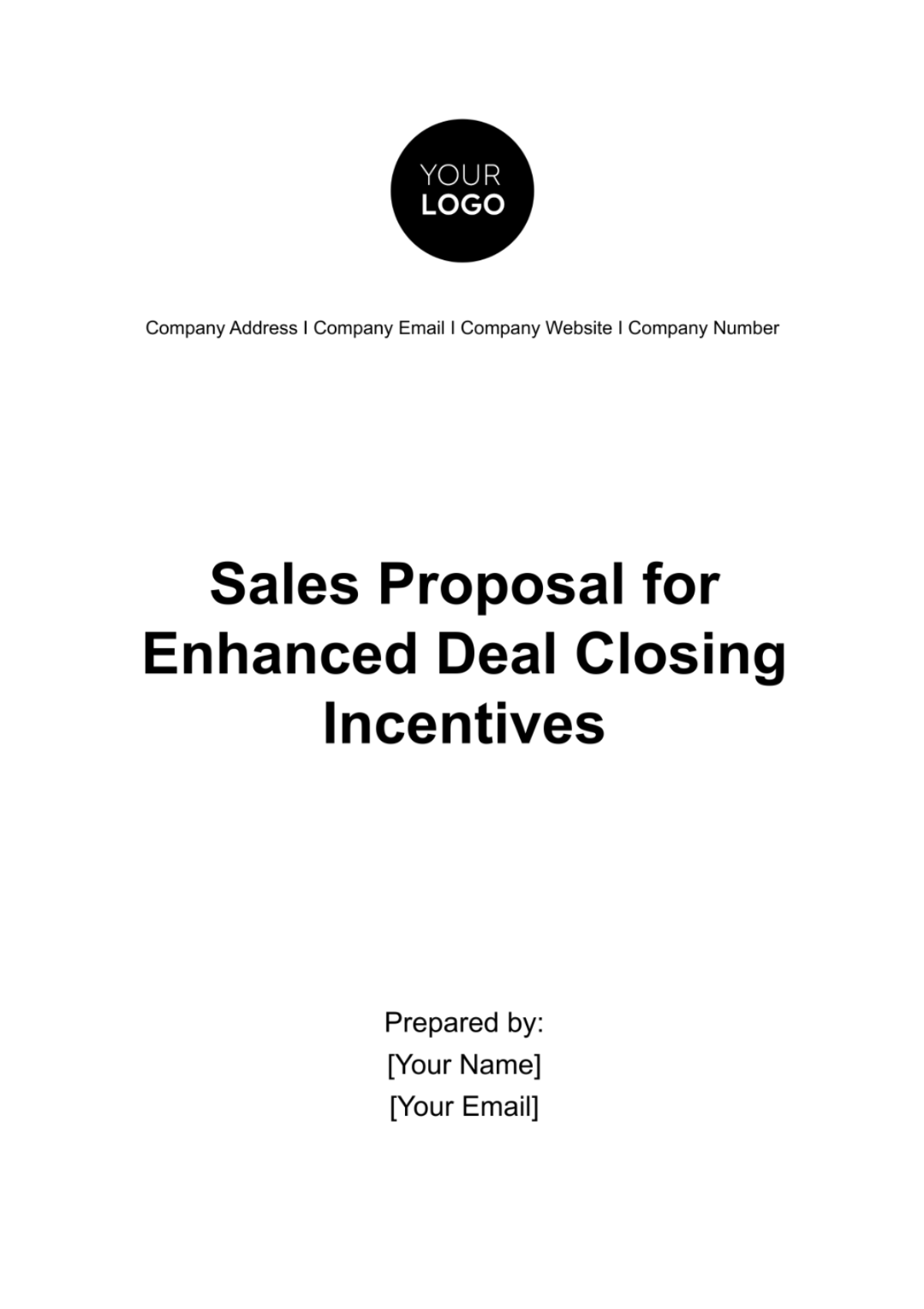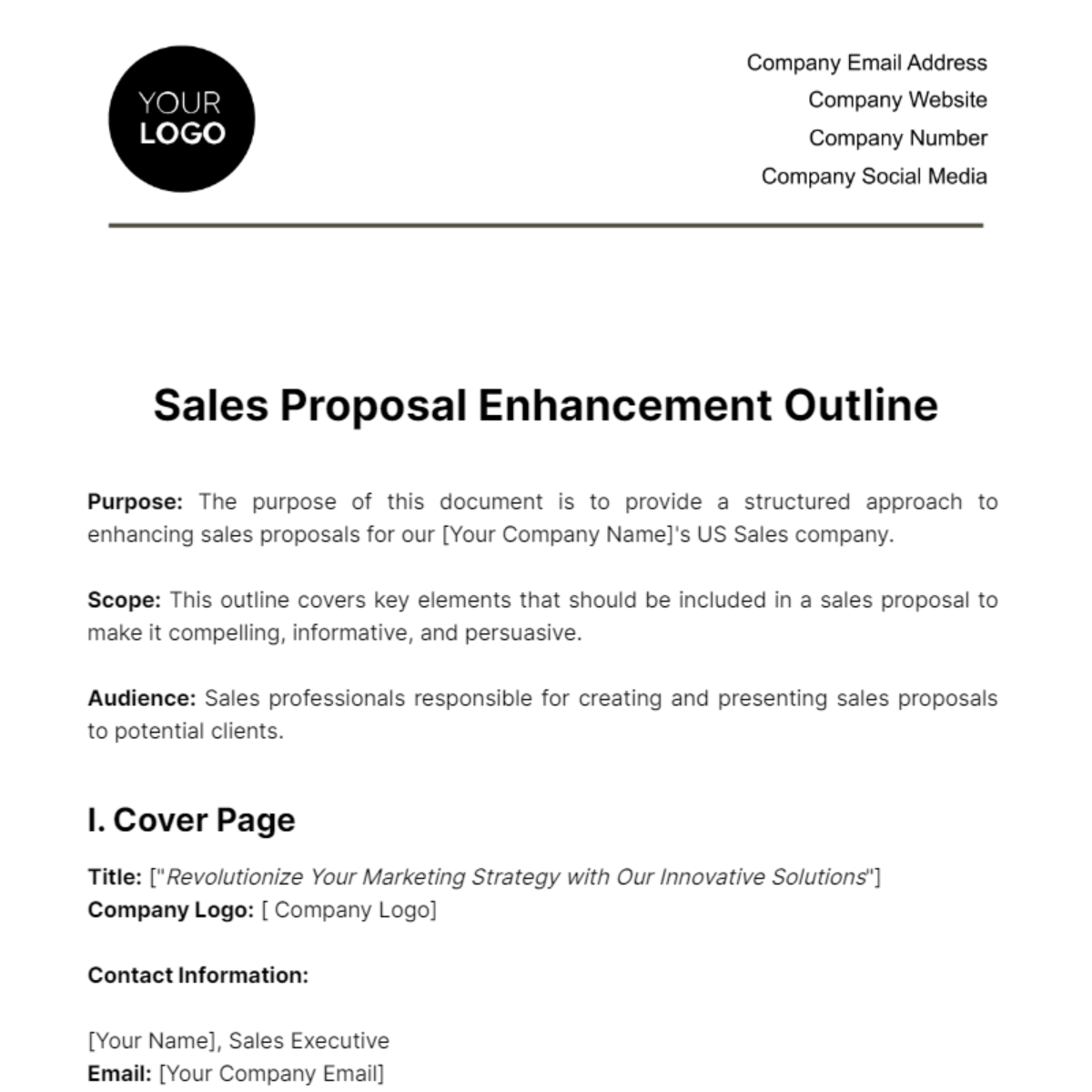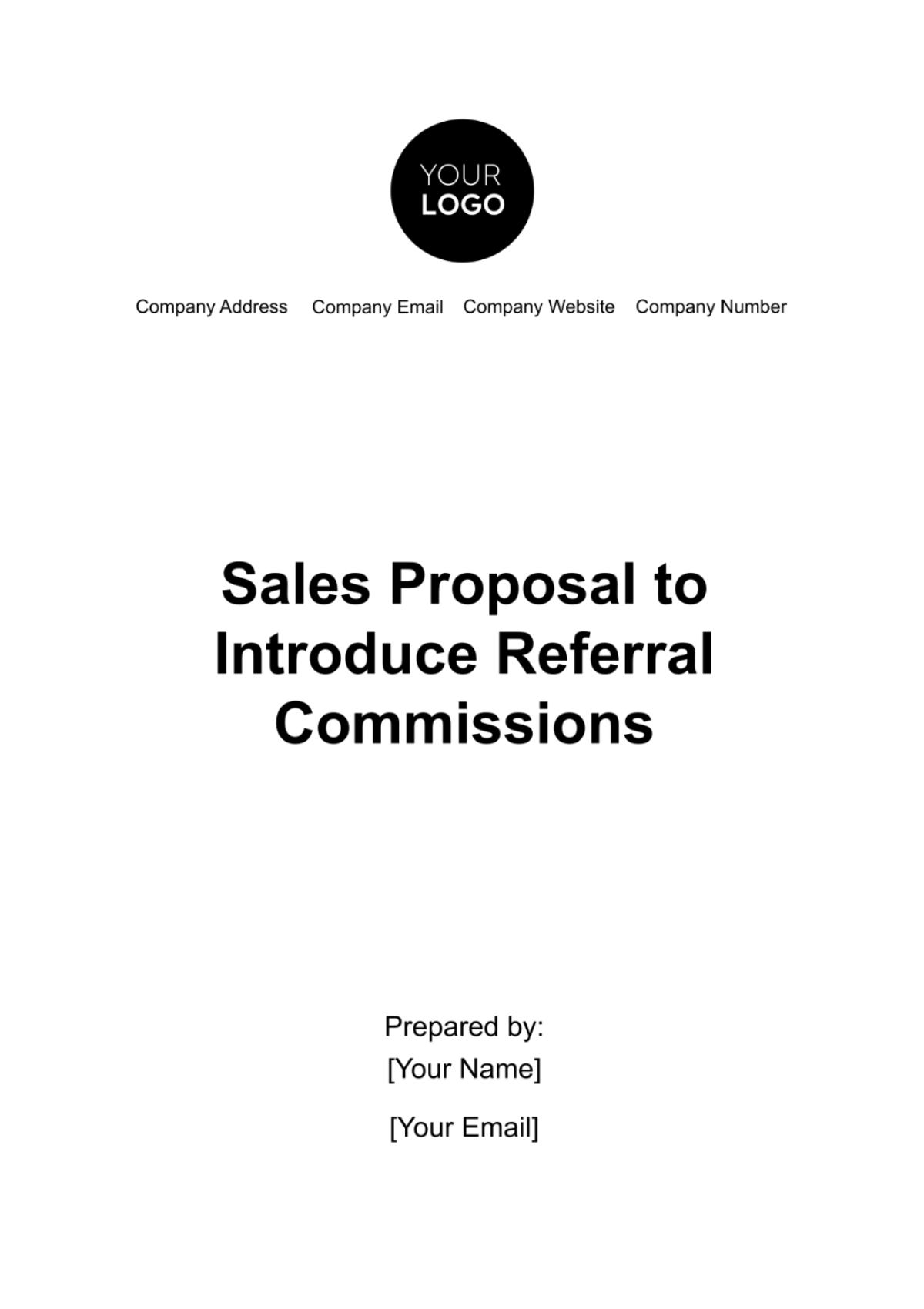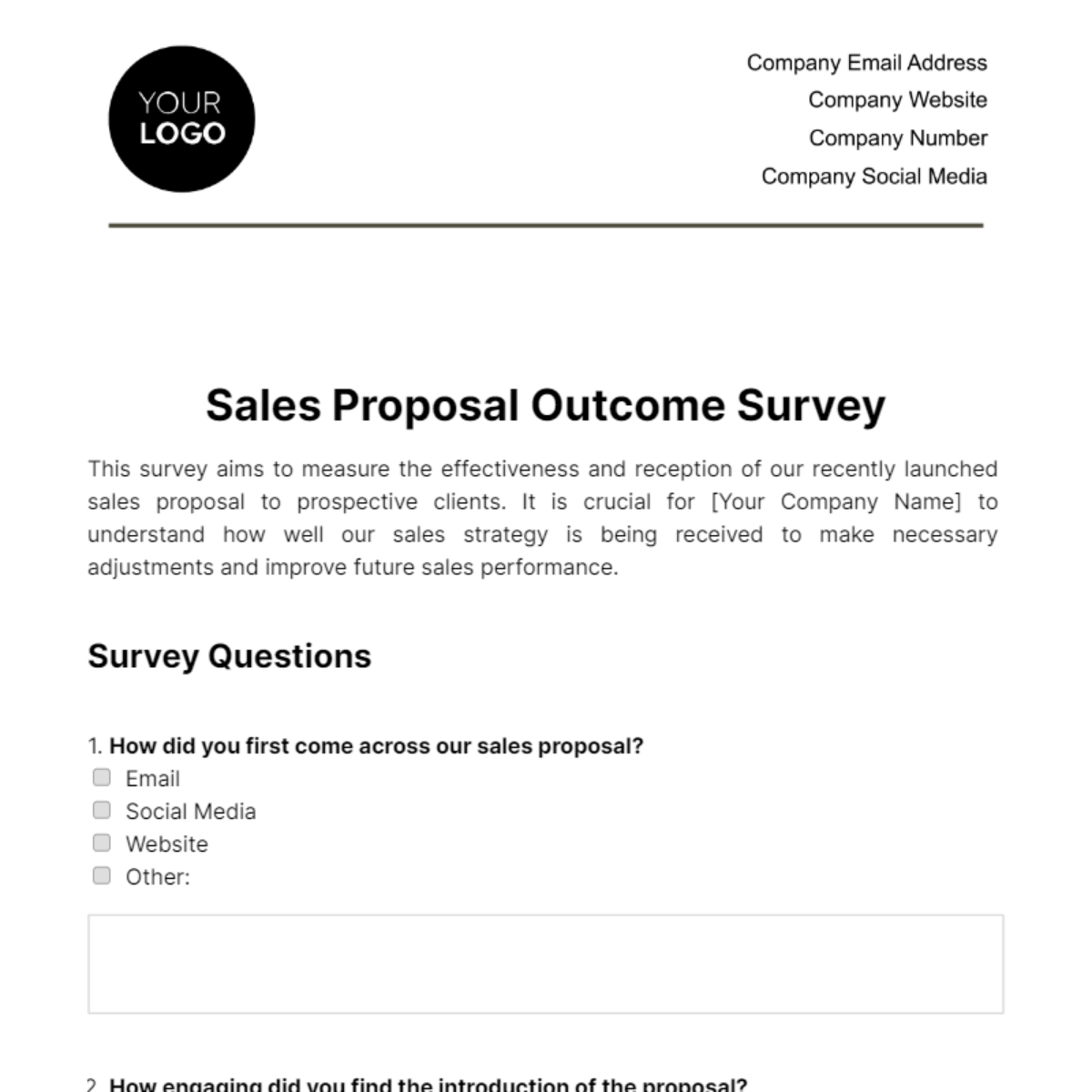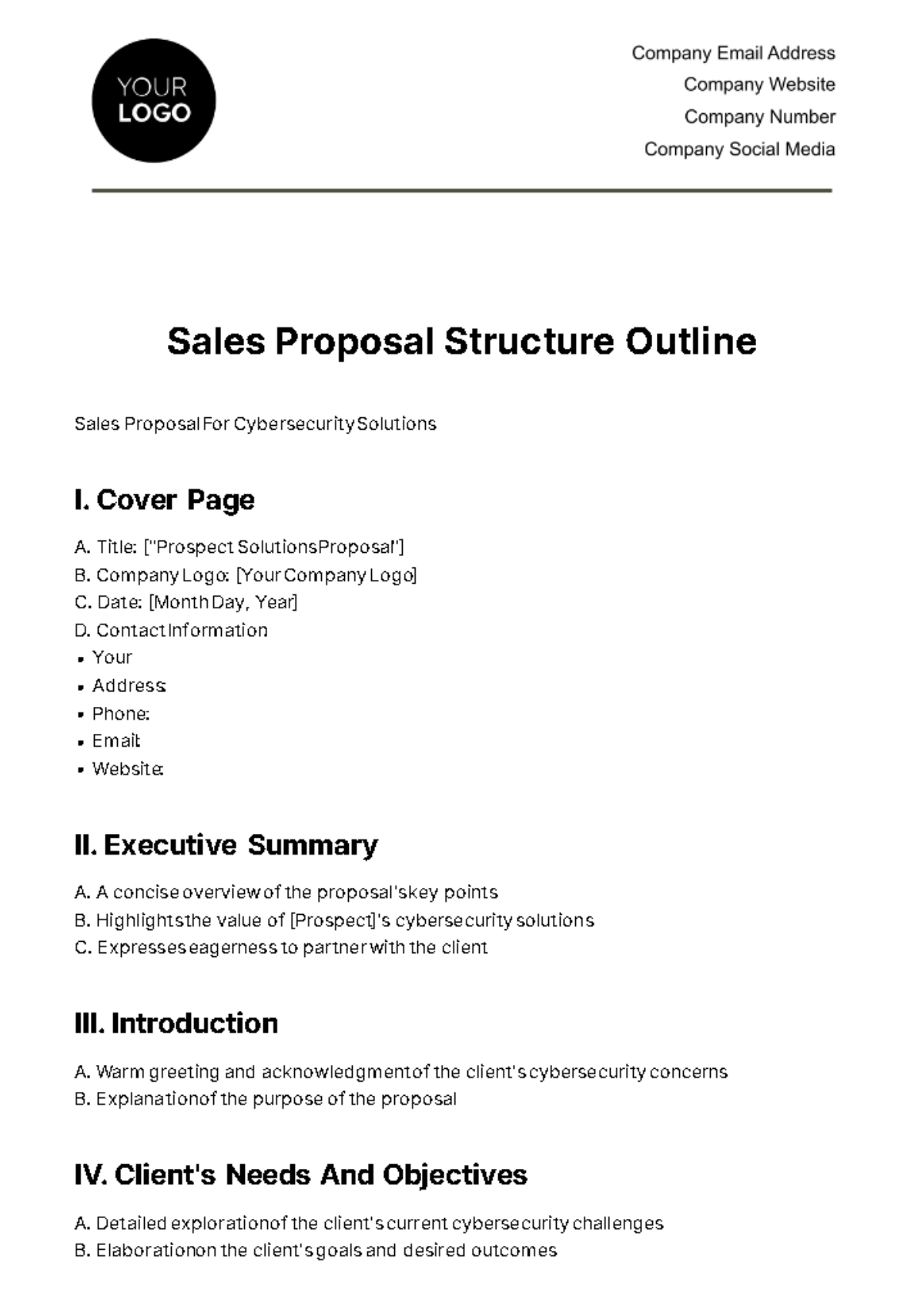Sales Proposal Writing Research
Introduction
The introduction section of this research provides a foundational understanding of the critical role that sales proposal writing plays in modern business. Sales proposals serve as a gateway to securing new clients and contracts, making them an integral part of any sales and business development strategy. They are not just documents; they are persuasive tools that bridge the gap between a potential client's needs and the solutions your company offers.
Purpose of the Research
The primary purpose of this research is to empower professionals involved in sales and business development with the knowledge, insights, and strategies necessary to excel in the art of sales proposal writing. By offering a comprehensive guide, we aim to enhance your ability to create compelling proposals that not only win contracts but also foster long-term client relationships. Our objective is to elevate the effectiveness of your sales proposals, making them powerful instruments for revenue generation.
Research Methodology
Our research methodology adheres to rigorous standards to ensure the accuracy and relevance of the insights presented. It encompasses a multifaceted approach:
Literature Review: We conduct an extensive review of academic studies, industry reports, and expert publications related to sales proposal writing.
Expert Interviews: We engage with seasoned professionals in the fields of sales, business development, and proposal writing to gain firsthand insights and best practices.
Market Analysis: Our team analyzes the competitive landscape and market trends to identify emerging practices and potential areas of innovation.
Case Studies: We scrutinize real-world case studies of both successful and unsuccessful sales proposals to distill key takeaways.
Data Collection: Data collection spans various industries, proposal types, and client profiles to provide a holistic view.
Key Findings
The culmination of our research has yielded several key findings:
Client-Centric Approach: Understanding and addressing the unique needs and pain points of clients is foundational to crafting persuasive proposals.
Content and Structure: The structure of a sales proposal, along with the quality and relevance of its content, significantly impacts its effectiveness.
Visual Elements: Incorporating visuals, charts, and graphics enhances engagement and comprehension.
Continuous Improvement: Tracking proposal metrics and applying insights for ongoing refinement is vital for long-term success.
Market Analysis
The sales proposal writing industry is experiencing a notable transformation. With the increasing digitization of business processes, the role of written proposals has expanded beyond traditional printed documents. This section provides a comprehensive overview of the industry landscape:
Digital Transformation: Proposals have evolved from paper-based documents to interactive digital presentations, reflecting the changing expectations of clients.
Global Reach: The ability to create and deliver proposals remotely has expanded market reach, enabling businesses to engage with clients globally.
Customization: Clients expect personalized proposals that directly address their unique challenges, creating a demand for tailored content.
Market Trends
Understanding the latest market trends is crucial for staying competitive in the field of sales proposal writing. Our research highlights the following key trends:
Personalization: Clients seek proposals that are tailored to their specific needs and objectives, emphasizing the importance of personalization.
Visual Communication: Visual elements, including infographics and interactive charts, are becoming integral to conveying complex ideas and data.
Automation and AI: Emerging technologies are streamlining proposal creation, from content generation to data analysis.
Sustainability: An increasing emphasis on sustainability and corporate social responsibility is influencing the content and messaging of proposals.
Competitor Analysis
Competitor analysis is essential for benchmarking your sales proposal writing practices. It involves a comprehensive evaluation of key players in the industry, including their strengths and weaknesses:
Market Leaders: Identify companies that consistently win contracts through their proposal strategies and examine what sets them apart.
Innovators: Explore businesses that have embraced technological innovations and new approaches to proposal writing.
Challenges: Recognize common pitfalls and challenges faced by competitors, allowing you to proactively address them in your own proposals.
Target Audience
Understanding your target audience is paramount for creating persuasive sales proposals. This section delves into the nuances of client preferences and pain points, providing insights into what influences their decision-making process:
Client Profiles: Explore the diverse range of clients your business caters to, from small startups to large enterprises.
Client Expectations: Understand the specific expectations and criteria clients use to evaluate proposals.
Client Pain Points: Identify common challenges and concerns that clients face during the proposal evaluation process.
Sales Proposal Writing Best Practices
In the realm of sales proposal writing, understanding your client's needs is the foundational step towards crafting persuasive proposals. This section goes into the intricacies of this crucial phase:
Needs Assessment: Begin by conducting a thorough needs assessment, involving direct communication with the client. This could include interviews, surveys, or consultations.
Problem Identification: Identify the specific challenges and pain points your client is facing. What problems are they trying to solve with your product or service?
Customization: Tailor your proposal to address these identified needs precisely. Clients value proposals that directly align with their unique requirements.
Value Proposition: Clearly articulate the value your product or service brings to the client's business. How will it solve their problems or enhance their operations?
Competitor Analysis: Understand what solutions competitors may be offering and how your proposal distinguishes itself.
Crafting a Compelling Sales Proposal
This section delves into the step-by-step process of crafting compelling sales proposals, ensuring that they stand out and resonate with potential clients:
Structuring the Proposal: Define a clear structure for your proposal. This typically includes an introduction, problem statement, solution, benefits, pricing, and a call to action.
Engaging Content: Craft persuasive and concise content. Use language that resonates with the client's industry and pain points.
Addressing Objections: Anticipate potential objections or questions the client may have and address them proactively in your proposal.
Showcasing Expertise: Highlight your company's expertise and experience in solving similar challenges for other clients.
Call to Action: End the proposal with a strong call to action, guiding the client on the next steps to engage with your company.
Tailoring Proposals to Different Industries
Sales proposals often span across various industries with unique requirements. This section provides guidance on adapting proposals effectively:
Industry Research: Thoroughly research the industry your client operates in. Understand industry-specific terminology, regulations, and challenges.
Template Customization: While having a proposal template is efficient, ensure it's flexible enough to adapt to different industries. Customize content and examples accordingly.
Industry-Specific Benefits: Emphasize how your product or service brings specific benefits to the client's industry. Address pain points that are industry-specific.
Effective Use of Visuals and Charts
Visual elements can significantly enhance the impact of your sales proposals. This section explores how to incorporate visuals effectively:
Data Visualization: When presenting data or statistics, use charts, graphs, and infographics to make complex information more digestible.
Engaging Graphics: Use engaging visuals to complement your content. Images, diagrams, and product illustrations can enhance understanding.
Consistency: Maintain a consistent visual style throughout the proposal to create a polished and professional look.
Clarity: Ensure that visuals are easy to understand and reinforce the message you want to convey.
Case Studies
Successful Sales Proposals
Analyzing successful sales proposals is invaluable for learning what works. In this section, we dissect real-world examples:
Proposal Summaries: Provide detailed summaries of successful proposals, highlighting key elements that contributed to their success.
Client Testimonials: If available, include client testimonials or feedback that underscores the proposal's effectiveness.
Metrics and Outcomes: Share measurable outcomes, such as increased revenue or client satisfaction, resulting from these proposals.
Best Practices: Extract best practices from these successful proposals that can be applied to your own writing.
Lessons Learned from Failed Proposals
Learning from failures is equally important. This section examines proposals that did not yield the desired results:
Analysis of Failures: Investigate why these proposals fell short. Were there critical errors in structure, content, or approach?
Recovery Strategies: Explore strategies for recovering from failed proposals, including client communication and proposal revisions.
Preventing Future Failures: Highlight lessons learned and steps to prevent similar failures in the future.
Real-World Examples
To provide inspiration and practical insights, we present a collection of real-world sales proposal examples from various industries:
Diverse Industries: Include proposals from a range of industries to demonstrate adaptability and industry-specific nuances.
Annotated Examples: Annotate the examples to explain why certain elements are effective and how they align with best practices.
Creative Elements: Showcase creative and innovative elements that set these proposals apart.
Templates and Tools: If available, provide templates and tools that readers can use as a starting point for their own proposals.
Proposal Metrics and Tracking
Key Performance Indicators (KPIs)
Tracking the performance of your sales proposals is essential for continuous improvement. In this section, we delve into the key performance indicators (KPIs) that should be monitored:
Proposal Acceptance Rate: Measure the percentage of proposals that are accepted by clients. This KPI reflects your proposal's effectiveness.
Conversion Rate: Calculate the ratio of proposals that lead to actual contracts or sales. Understanding this rate helps refine your approach.
Response Time: Track the time it takes for clients to respond to your proposals. Quick responses can signal strong interest.
Engagement Metrics: Use analytics to monitor how clients engage with your digital proposals, including time spent on each section and interaction with visuals.
Feedback and Surveys: Collect client feedback through surveys to gauge satisfaction and areas for improvement.
Proposal Tracking Tools
Efficiently tracking proposals requires the right tools and systems. This section explores the tools and technologies available:
Proposal Management Software: Discuss the benefits of using dedicated proposal management software, such as document tracking, analytics, and collaboration features.
CRM Integration: Highlight how integrating proposal tracking with your Customer Relationship Management (CRM) system streamlines data management and client communication.
Email Tracking: Explain how email tracking tools can provide insights into when clients open proposals and engage with the content.
Custom Reporting: Customize reporting based on your specific KPIs and needs, ensuring that you gather relevant data for analysis.
Continuous Improvement Strategies
Effective proposal tracking is not just about collecting data but also about using it to drive improvement:
Data Analysis: Discuss the importance of regular data analysis to identify trends and areas for enhancement.
A/B Testing: Explain how A/B testing different proposal elements can help refine your approach over time.
Feedback Loop: Establish a feedback loop within your organization, where insights from proposal tracking inform proposal creation strategies.
Training and Development: Invest in training and development for your sales and business development teams to ensure they can leverage data effectively.
Pricing Strategies
Pricing Models
Choosing the right pricing model is a critical aspect of sales proposal writing. In this section, we explore various pricing models:
Fixed Pricing: Explain how fixed pricing involves setting a specific price for a product or service, often used for standardized offerings.
Tiered Pricing: Discuss tiered pricing, where different packages or levels of service are offered at varying price points.
Value-Based Pricing: Highlight the concept of value-based pricing, where the price is determined based on the perceived value to the client.
Subscription Models: Explore subscription-based pricing, which involves recurring payments for ongoing services.
Custom Pricing: Explain how custom pricing is tailored to the client's unique needs, often requiring individualized proposals.
Value-Based Pricing
Value-based pricing is a sophisticated strategy that deserves dedicated attention:
Value Assessment: Explain how to assess the value your product or service brings to the client's business. This involves understanding their pain points and potential gains.
Pricing Strategies: Discuss different value-based pricing strategies, such as cost-plus pricing, competitive benchmarking, and willingness-to-pay analysis.
Communicating Value: Highlight the importance of effectively communicating the value proposition in your proposal to justify pricing.
Negotiation Techniques: Offer insights into negotiating value-based pricing with clients, addressing objections and demonstrating ROI.
Competitive Pricing Strategies
Competitive pricing strategies can be a game-changer in sales proposal writing:
Competitor Analysis: Revisit the importance of competitor analysis, particularly in the context of pricing. Understand how your pricing compares to competitors.
Price Positioning: Discuss strategies for positioning your pricing in the market, whether as a cost leader, value leader, or premium provider.
Discounting and Incentives: Explain how to strategically use discounts, incentives, and bundling to make your proposals more appealing while maintaining profitability.
Long-term Value: Emphasize the long-term value of your offerings, even if they appear higher priced initially.
Proposal Presentation
Design and Formatting
The visual presentation of your sales proposal can greatly impact its effectiveness. In this section, we explore the critical elements of design and formatting:
Professional Layout: Emphasize the importance of a clean and professional layout. Use consistent fonts, colors, and formatting throughout the document.
Visual Hierarchy: Explain how to create a visual hierarchy with headings, subheadings, and bullet points to make the proposal easy to navigate.
Whitespace: Discuss the strategic use of whitespace to reduce clutter and make the proposal more readable.
Visual Branding: Highlight the significance of incorporating your company's branding elements, such as logo and color scheme, for a cohesive look.
Accessibility: Address the importance of accessibility, ensuring that the proposal is easily readable for all clients, including those with disabilities.
Incorporating Client Branding
Customizing your proposal to include the client's branding elements can demonstrate a deep understanding of their needs. This section provides guidance on this aspect:
Client Logo and Colors: Explain how to incorporate the client's logo and color scheme to create a personalized touch.
Tone and Language: Discuss the importance of aligning the proposal's tone and language with the client's brand voice and values.
Case Studies and References: Highlight relevant case studies and references that showcase your ability to work within the client's industry or sector.
Effective Storytelling Techniques
Storytelling can make your sales proposal more engaging and memorable. This section explores storytelling techniques:
Narrative Structure: Explain how to structure your proposal like a story, with a clear beginning, middle, and end.
Client-Centric Stories: Share examples of how to incorporate client success stories or testimonials to illustrate the value of your offerings.
Problem-Solution Narrative: Show how framing your proposal as a solution to the client's specific challenges can create a compelling narrative.
Visual Storytelling: Discuss how visual elements, such as images and infographics, can enhance the storytelling aspect of your proposal.
Conclusion
In this research on sales proposal writing, we have explored a wide array of topics, strategies, and best practices to help you excel in this essential aspect of business development. Let's recap some of the key takeaways from this comprehensive research:
Client-Centric Approach: Centralize your proposals around understanding and addressing the unique needs of your clients. Personalization is key to success.
Craftsmanship in Proposal Creation: Crafting compelling proposals is both an art and a science. Pay attention to structure, content, language, and visual elements.
Adaptability Across Industries: Tailoring proposals to the specific requirements of different industries is crucial for success in diverse markets.
Visual Impact: The strategic use of visuals, charts, and graphics can significantly enhance the impact of your proposals.
Data-Driven Improvement: Tracking proposal metrics and analyzing data is essential for continuous improvement.
Pricing Strategy: Choose pricing models that align with your client's perceived value while maintaining profitability.
Effective Presentation: The design, formatting, and storytelling aspects of your proposal greatly influence its effectiveness.
If you have any questions, need further assistance, or would like to explore how our [Your Company Name] services can support your proposal writing needs, please do not hesitate to reach out to us.











